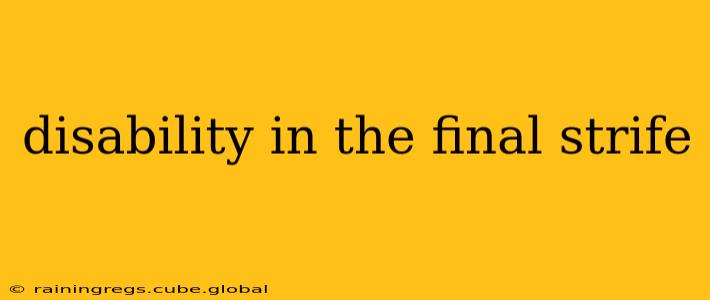Disability in the Final Strife: Exploring Representation and Challenges in Fantasy Literature
Fantasy literature, with its sweeping epics and fantastical creatures, often presents a powerful stage for exploring complex themes. However, the representation of disability within these narratives is a nuanced and often problematic area. While strides have been made, many works still fall short of offering authentic and nuanced portrayals, perpetuating harmful stereotypes or ignoring the lived experiences of disabled individuals altogether. This exploration delves into the current state of disability representation in fantasy literature, examining both the challenges and the potential for positive change.
What are some common tropes of disability in fantasy literature?
Many fantasy works employ disability as a mere plot device, often associating it with villainy, monstrosity, or a source of magical power. This can reinforce harmful stereotypes, reducing disabled characters to one-dimensional archetypes rather than fully realized individuals. Common tropes include:
- The "cursed" disabled character: Disability is presented as a punishment or a consequence of a magical mishap, reinforcing a narrative of blame and stigma.
- The "magical cure" trope: Disability is portrayed as something to be overcome or "fixed," often through magical means, implying that disability is inherently undesirable.
- The monstrous disabled character: Disability is equated with monstrosity or otherness, fueling fear and prejudice. This often leads to the disabled character being portrayed as a villain or a threat.
These tropes, while prevalent, are ultimately reductive and fail to represent the diverse experiences of disabled individuals.
How can fantasy authors improve their portrayal of disability?
Improving the representation of disability in fantasy literature requires a conscious effort to move beyond these harmful tropes. Authors can achieve this by:
- Centering disabled characters' narratives: Don't just include disabled characters as sidekicks or plot points; let them drive the story and have their own complex journeys and motivations.
- Creating diverse representations of disability: Show the full spectrum of disability experiences, avoiding generalizations and stereotypes. Include a range of disabilities, both visible and invisible.
- Avoiding "inspiration porn": Resist the temptation to portray disabled characters solely as inspirational figures who overcome their challenges with unwavering positivity. Disability is a lived experience, not a source of constant inspiration.
- Working with disability consultants: Collaborate with disabled individuals to ensure authentic representation and avoid perpetuating harmful stereotypes.
Is disability always portrayed negatively in fantasy?
While many examples showcase negative portrayals, some fantasy works are beginning to challenge these tropes and offer more nuanced and positive representations. These stories often:
- Explore the challenges and triumphs of living with a disability: They showcase the resilience, creativity, and strength of disabled characters.
- Challenge ableist assumptions and societal biases: They invite readers to question their own preconceived notions about disability.
- Normalize disability: They depict disability as a natural part of human diversity, reducing stigma and promoting inclusion.
What are some examples of good and bad disability representation in fantasy? (Note: Specific examples require careful analysis and contextual understanding, and providing them here risks potentially misinterpreting or oversimplifying complex characters and narratives. A more in-depth examination would necessitate a separate, dedicated article.)
How can readers promote better representation of disability in fantasy?
Readers play a crucial role in promoting better representation. By:
- Supporting authors who create authentic portrayals: Choosing to read and review books that offer positive and nuanced depictions of disability sends a powerful message to publishers and authors.
- Calling out harmful stereotypes: Don't be afraid to voice your concerns about problematic representations in books, reviews, and online discussions.
- Demanding better representation: Encourage publishers and authors to prioritize inclusion and create diverse stories that reflect the richness of human experience.
Ultimately, improving the representation of disability in fantasy literature is a collective responsibility. By challenging harmful tropes, fostering authentic portrayals, and promoting inclusive narratives, we can create a more diverse and representative fantasy landscape that reflects the lived experiences of disabled individuals. This will not only enrich the genre but also contribute to broader societal understanding and acceptance.
